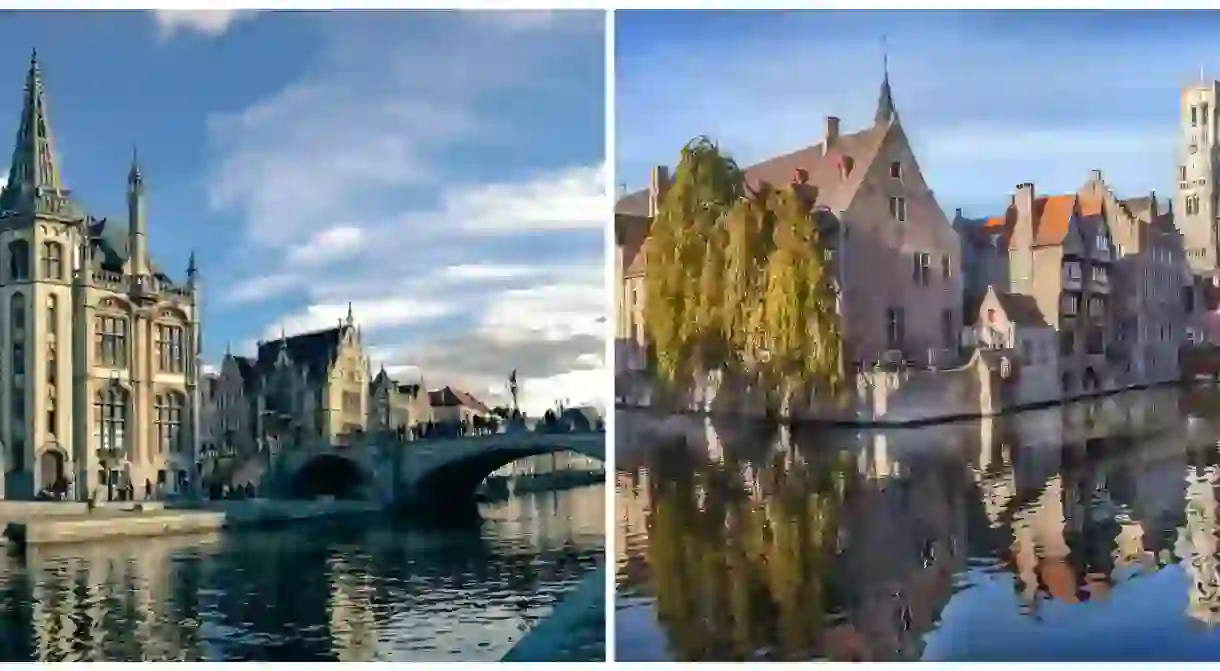Ghent or Bruges: Which City Is for You?

With both historic destinations bathing in canals and medieval quaintness, touristic Bruges is spoken of as the ultimate European flashback, while larger Ghent is often hailed as being more authentic. So which of these Old World Belgian pearls should you go with for a quick getaway? Read through this comparative guide, search your own travel soul, and listen to what your stomach, nightlife needs, and cultural thirsts are telling you.
Food: vegetarian heaven and the finest dining
If you’re traveling with a vegetarian or happen to be one yourself, Ghent sits ready to blow your socks off. A bit of an anomaly in carnivorous Flanders, the northwest city made European headlines by being the first to announce a weekly ‘veggie day’ in 2009, and it offers multiple vegan buffets – an elusive find in the country – and embraces organic shops and markets as a mainstream alternative. Besides an abundance of quality vegetarian eateries, other gastronomic hot spots such as Publiek and Oak serve a mean veggie or vegan menu on demand.

In good old Bruges, the concern is less about the veggies and more about an intriguing juxtaposition of tradition and innovation. While chocolate magician Dominique Persoone whips up pralines with wasabi, and Philippe Serruys of Den Gouden Harynck likes to use his classically schooled skills for particularly modern dishes, homey establishments such as Den Huzaar and In ‘t Nieuw Museum keep it comfortable with beer-rich stews and treasures from the nearby North Sea. When looking to count Belgian Michelin stars, Bruges is where to find them.
Nightlife: boisterous Ghent and subdued Bruges
Being a student city and generally bigger than Bruges, Ghent naturally has one leg up when it comes to nights out on the town. Live music bars Hot Club de Gand and Charlatan are institutions that stay open until the wee hours of the morning, as do the latter’s neighbors on the Vlasmarkt Square. Cocktail bars are in big supply, from lounges to speakeasies (try Jigger’s, “The Noble Drugstore,” for herbal mixology at its best), and dance temples like Club 69 and Decadance provide after-hours fun. The 10-day summer festival Gentse Feesten has evolved over the past 150 years to become one of Europe’s biggest and most beloved city celebrations.

Next to Ghent and its prominent wild streak, upscale Bruges can come across as a bit of a goody-two-shoes – at first glance. With clubs few and far between and its cobbled streets incredibly peaceful, the “Venice of the North” might even lead some to believe it’s completely dead during fall and winter evenings. The actual reason behind the tranquility is that everyone is down in cozy medieval cellar bars and music pubs, where they are having a jolly good time while sampling a plethora of Belgian beers. Indeed, Bruggenaars know exactly how to spend a night out.

Museums and art scene: Flemish Primitives and Flemish originals
Bruges is chockablock full of museums including the Choco-Story and the French Fry Museum – yes, complete with samples of the respective Belgian treats they dedicate themselves to – but shining brightest amongst the masses is the Groeningemuseum. This pantheon of Flemish masters holds an impressive collection of paintings by Jan Van Eyck, Hans Memling, and other early Netherlandish creatives, many of whom lived in Bruges during its Golden Age to duly capture all of the splendor.

For all of Bruges’ cultural past with a capital “C” though, Ghent gets to show off the most creative present. There’s a freshness and a colorfulness (check out Graffiti Alley and other street art spread all over) to the city that’s made it a favorite artist hub, as proven by the public work The Virgin, a gift from renowned painter Michaël Borremans to his hometown. Great places to soak up the bubbling innovation are the S.M.A.K. (museum for contemporary art) and the House of Alijn, a small-scale, relaxed place dedicated to the art of the everyday. There is also the Design Museum, which takes a look back at the popular decorative and architectural movements in Belgium all the way up to Art Deco and Modernism.

History: gingerbread town and 12th-century defiance
Looking down on creation from atop Bruges’ Belfry, 83 meters (272.3 feet) high, it’s an ancient world that lies beneath. In the end, what has made the ancient port city such a fairytale destination is its status as one of the best-preserved medieval settlements in the world. The 15th-century street pattern has been largely kept intact, and two World Wars left the sleepy city unscathed. Its original web of canals and step-gabled merchant houses – really the entire gingerbread-like center – were labeled a UNESCO World Heritage Site in 2000.

Mightily underrated in the past, Ghent as a historic destination is less obvious. Only in recent years have international publications and travel guides started paying attention to Flanders’ most rebellious city, whose citizens have defied everyone from 12th-century Flemish Counts to Charles V, Holy Roman Emperor. Grand guild and patrician houses still line the banks of its river Leie, and its imposing Castle of the Counts (Gravensteen) functioned as the region’s seat of power long before there was a Belgium to speak of. While Bruges escaped the talons of industrialization, Ghent nestled itself at the heart of it with a thriving textile industry, and despite its significant growth, the city has managed to hold onto the treasures of its illustrious past. A prime example would be Saint Bavo’s Cathedral, the magnificent home to the Van Eyck brothers’ The Adoration of the Mystic Lamb, an altarpiece that has inspired as many pilgrimages as it has thefts.














